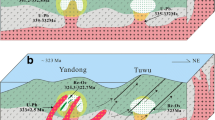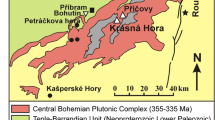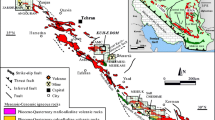Abstract
Major Cu–Au deposits of iron oxide–copper–gold (IOCG) style are temporally associated with oxidized, potassic granitoids similar to those linked to major porphyry Cu–Au deposits. Stable and radiogenic isotope evidence indicates fluids and ore components were likely sourced from the intrusions. IOCG deposits form over a range of crustal levels because CO2-rich fluids separate from the magmas at higher pressures than in CO2-poor systems, thereby, promoting partitioning of H2O, Cl and metals to the fluid phase. At deep levels, the magma–fluid system cannot generate sufficient mechanical energy to fracture the host rocks as in porphyry systems and the IOCG deposits therefore form in a variety of fault-related structural traps where the magmatic fluids may mix with other fluids to promote ore formation. At shallow levels, the IOCG deposits form breccia and fracture-hosted mineralization styles similar to the hydrothermal intrusive breccias and sulphide vein systems that characterize many porphyry Cu–Au deposits. The fluids associated with IOCG deposits are typically H2O–CO2–salt fluids that evolve by unmixing of the carbonic phase and by mixing with fluids from other sources. In contrast, fluids in porphyry systems typically evolve by boiling of moderate salinity fluid to produce high salinity brine and a vapor phase commonly with input of externally derived fluids. These different fluid compositions and mechanisms of evolution lead to different alteration types and parageneses in porphyry and IOCG deposits. Porphyry Cu–Au deposits typically evolve through potassic, sericitic and (intermediate and/or advanced) argillic stages, while IOCG deposits typically evolve through sodic(–calcic), potassic and carbonate-rich stages, and at deeper levels, generally lack sericitic and argillic alteration. The common association of porphyry and IOCG Cu–Au deposits with potassic, oxidized intermediate to felsic granitoids, together with their contrasting fluid compositions, alteration styles and parageneses suggest that they should be considered as part of the broad family of intrusion-related systems but that they are typically not directly related to each other.


Similar content being viewed by others
References
Baker T, Perkins C, Blake KL, Williams PJ (2001) Radiogenic and stable isotope constraints on the genesis of the Eloise Cu–Au deposit, Cloncurry district, northwest Queensland. Econ Geol 96:723–742
Barton MD, Johnson DA (1996) Evaporitic-source model for igneous-related Fe oxide–(REE–Cu–Au–U) mineralization. Geology 24:259–262
Barros CEM, Dall’Agnol R, Barbey P, Boullier A-M (1997) Geochemistry of the Estrella granite complex, Carajás region, Brazil: an example of an Archean A-type granitoid. J South Am Earth Sci 10:321–330
Barros CEM, Sardinha AS, Barbosa JPO, Krimski R, Macambira MJB (2001) Pb–Pb and U–Pb zircon ages of Archean syntectonic granites of the Carajás metallogenic province, northern Brazil. III South American Symposium on Isotope Geology, Pucon, Chile, 21–24th October 2001, Compact Disk
Betts PG, Giles D, Lister GS, Frick LR (2002) Evolution of the Australian Lithosphere. Aust J Earth Sci 49:661–695
Blevin PL, Chappell BW (1992) The role of magma sources, oxidation states and fractionation in determining the granite metallogeny of eastern Australia. Trans R Soc Edinb 83:305–316
Blevin PL, Chappell (1995) Chemistry origin and evolution of mineralized granites in the Lachlan Fold Belt, Australia: the metallogeny of I- and S-type granites. Econ Geol 90:1604–1619
Budd A, Wyborn L, Bastrakova I (1998) Exploration significance of the Hiltaba Suite, South Australia. Australian Geological Survey Organization Research Newsletter 29:1–4
Burnham CW, Ohmoto H (1980) Late stage processes in felsic magmatism. In: Ishihara S and Takenouchi S (eds) Society of mining geologists of Japan. Mining Geology Special Issue 8:1–12
Campbell IH, Compston DM, Richards JP, Johnson JP, Kent AJR (1998) Review of the application of isotopic studies to the genesis of Cu–Au mineralization at Olympic Dam and Au mineralization at Porgera, the Tennant Creek district and Yilgarn Craton. Aust J Earth Sci 45:201–218
Candela PA (1989) Felsic magmas, volatiles, and metallogenesis. In: Whitney JA, Naldrett AJ (eds) Ore deposition associated with magmas: Society of Economic Geol Rev Econ Geol 4:223–233
Creaser RA (1996) Petrogenesis of a Mesoproterozoic quartz latite-granitoid suite from the Roxby Downs area, South Australia. Precambrian Res 79:371–394
Creaser RA, Cooper JA (1993) U–Pb geochronology of middle Proterozoic felsic magmatism surrounding the Olympic Dam Cu–U–Au–Ag and Moonta Cu–Au–Ag deposits, South Australia. Econ Geol 88:186–197
Creaser RA, Price RC, Wormald RJ (1991) A-type granites revisited: assessment of a residual source model. Geology 19:163–166
Dallmeyer RD, Brown M, Grocott J, Taylor GK, Treloar PJ (1996) Mesozoic magmatic and tectonic events within the Andean plate boundary zone, 26°–27°30′ S, north Chile: constraints from 40Ar/39Ar mineral ages. J Geol 104:19–40
Dardenne MA, Ferreira Filho CF, Meirelles MR (1988) The role of shoshonitic and calc-alkaline suites in the tectonic evolution of the Carajás district, Brazil. J South Am Earth Sci 1:363–372
Ferris GM, Schwarz MP, Heithersay P (2002) The geological framework, distribution and controls of Fe-oxide Cu–Au mineralization in the Gawler Craton, South Australia: Part 1. Geological and tectonic framework. In: Porter TM (ed.) Hydrothermal iron oxide copper–gold and related deposits: a global perspective, Vol. 2. PGC Publishing, Adelaide, pp 9–31
Gauthier L, Hall G, Stein H, Schaltegger U (2001) The Osborne deposit, Cloncurry district: a 1595 Ma Cu–Au skarn deposit. In: Williams PJ (ed.) 2001—A Hydrothermal Odyssey, Townsville May 17–19, 2001: Economic Research Unit, James Cook University Contribution 59:58–59
Haynes DW, Cross KC, Bills RT, Reed MH (1995) Olympic Dam ore genesis: a fluid-mixing model. Econ Geol 90:281–307
Holdsworth RE, Pinheiro RVL (2000) The anatomy of shallow-crustal transpressional structures: insights from the Archaean Carajás fault zone, Amazon, Brazil. J Struct Geol 22:1105–1123
Ishihara S (1981) The granitoid series and mineralization. Economic Geology 75th Anniversary Volume, pp 458–484
Irvine TN, Barragar RA (1971) A guide to the chemical classification of the common volcanic rocks. Can J Earth Sci 8:523–548
Johnson DA, Barton MD (2000) Time–space development of an external brine-dominated, igneous-driven hydrothermal system: Humboldt mafic complex, western Nevada. In Dilles JH, Barton MD, Johnson DA, Proffett, JM, Einaudi MT (eds.) Contrasting styles of intrusion-associated hydrothermal systems: Society of Economic Geologists Guidebook Series 32:127–144
Johnson JP, Cross KC (1995) U-Pb Geochronological constraints on the genesis of the Olympic Dam Cu–U–Au–Ag deposit, South Australia. Econ Geol 90:1046–1063
Johnson JP, McCulloch MT (1995) Sources of mineralizing fluids for the Olympic Dam deposit (South Australia): Sm–Nd isotopic constraints. Chem Geol 121:177–199
Keppler H (1993) Influence of fluorine on the enrichment of high field strength trace elements in granitic rocks. Contrib Mineral Petrol 114:479–488
Lang JR, Stanley, CR, Thompson JFH (1995) Porphyry copper–gold deposits related to alkaline igneous rocks in the Triassic–Jurassic are terranes of British Columbia. In: Pierce FW, Bolm JG (eds) Porphyry copper deposits of the American Cordillera. Ariz Geol Soc Dig 20:216–236
Lehmann B (1990) Metallogeny of tin. Lecture notes in Earth Sciences. Springer, Berlin Heidelberg New York, pp 211
Lindenmayer ZG, Fyfe WS, Bocalon VLS (1994) Nota preliminar sobre as intrusoes granitoides do deposito de cobre do Salobo, Carajas. Acta Geol Leopold 40:153–184
Lowenstern JB (2001) Carbon dioxide in magmas and implications for hydrothermal systems. Miner Depos 36:490–502
Machado M, Lindenmayer Z, Krogh TE, Lindenmayer D (1991) U–Pb geochronology of Archean magmatism and basement reactivation in the Carajás area, Amazon shield, Brazil. Precambrian Res 49:329–354
Mark G, Foster DRW, Pollard PJ, Williams PJ, Tolman J, Darvall M, Blake KL (2004) Stable isotope evidence for magmatic fluid input during large-scale Na–Ca alteration in the Cloncurry Fe oxide Cu–Au district, NW Queensland, Australia. Terra Nova 16:54–61
Mark G, Oliver NHS, Williams PJ (2006) Mineralogical and chemical evolution of the Ernest Henry Fe oxide–Cu–Au ore system, Cloncurry district, northwest Queensland, Australia. Miner Depos (in press)
Mark G, Oliver NHS, Williams PJ, Valenta RK, Crookes RA (2000) The evolution of the Ernest Henry Fe-oxide–(Cu–Au) hydrothermal system. In: Porter TM (ed) Hydrothermal iron oxide copper–gold and related deposits: a global perspective, Australian Mineral Foundation, Adelaide, pp 123–136
Marschik R, Fontboté L (2001) The Candelaria–Punta del Cobre iron oxide Cu–Au(–Zn–Ag) deposits, Chile. Econ Geol 96:1799–1826
Marschik R, Singer BS, Munizaga F, Tassinari C, Moritz R, Fontboté L (1997) Age of Cu(–Fe)–Au mineralization and thermal evolution of the Punta del Cobre district, Chile. Miner Depos 32:531–546
Marschik R, Chiaradia M, Fontboté L (2003a) Implications of Pb isotope signatures of rocks and iron oxide Cu–Au ores in the Candelaria–Punta del Cobre district, Chile. Miner Depos 38:900–912
Marschik R, Fontignie D, Chiaradia M, Voldet P (2003b) Geochemical and Sr–Nd–O isotope composition of granitoids of the Early Cretaceous Copiapó plutonic complex (27°30′ S), Chile. J South Am Earth Sci 16:381–398
Marschik R, Spangenberg JE, Leveille RA, de Almeida AJ (2003c) The Sossego iron oxide Cu–Au deposit, Carajás, Brazil. In: Eliopoulos DG et al (eds.) Mineral exploration and sustainable development. Millpress, Rotterdam, pp 331–334
Mathur R, Marschik R, Ruiz J, Munizaga F, Leveille R, Martin W (2002) Age of mineralization of the Candelaria Fe oxide Cu–Au deposit and the origin of the Chilean iron belt, based on Re–Os isotopes. Econ Geol 97:59–71
McLean MA, Betts PG (2003) Geophysical constraints of shear zones and geometry of the Hiltaba Suite granites in the Gawler Craton, Australia. Aust J Earth Sci 50:525–541
Oliver NHS, Cleverley JS, Mark G, Pollard PJ, Fu B, Marshall LJ, Rubenach MJ, Williams PJ, Baker T (2004) Modeling the role of sodic alteration in the genesis of iron oxide–copper–gold deposits, Eastern Mount Isa Block, Australia. Econ Geol 99:1145–1176
Oreskes N, Einaudi MT (1990) Origin of rare earth element-enriched hematite breccias at the Olympic Dam Cu–U–Au–Ag deposit, Roxby Downs, South Australia. Econ Geol 85:1–28
Oreskes N, Einaudi M (1992) Origin of hydrothermal fluids at Olympic Dam: preliminary results from fluid inclusions and stable isotopes. Econ Geol 87:64–90
Page RW, Sun S-S (1998) Aspects of geochronology and crustal evolution in the Eastern Fold Belt, Mount Isa Inlier. Aust J Earth Sci 45:343–361
Peccerillo A, Taylor SR (1976) Geochemistry of Eocene calc-alkaline volcanic rocks from the Kastamonu area, northern Turkey. Contrib Mineral Petrol 58:63–81
Pearce JA, Harris NBW, Tindle AG (1984) Trace element discrimination diagrams for the tectonic interpretation of granitic rocks. J Petrol 25:956–983
Perkins C, Wyborn LAI (1998) Age of Cu–Au mineralization, Cloncurry district, eastern Mt Isa Inlier, as determined by 40Ar/39Ar dating. Aust J Earth Sci 45:233–246
Perring CS, Pollard PJ, Dong G, Nunn AJ, Blake KL (2000) The Lightning Creek sill complex, Cloncurry district, northwest Queensland: a source of fluid for Fe-oxide–Cu–Au mineralization and sodic–calcic alteration. Econ Geol 95:1067–1069
Pollard PJ (2000) Evidence of a magmatic fluid and metal source for Fe-oxide Cu–Au mineralization. In: Porter TM (ed) Hydrothermal iron oxide copper–gold and related deposits: a global perspective, vol 1. PGC, Adelaide, pp 27–41
Pollard PJ (2001) Sodic(-calcic) alteration in Fe-oxide Cu–Au districts: an origin via unmixing of magmatic H2O–CO2–NaCl ± CaCl2–KCl fluids. Miner Depos 36:93–100
Pollard PJ, Mark G, Mitchell LC (1998) Geochemistry of post-1540 Ma granites in the Cloncurry district, northwest Queensland. Econ Geol 93:1330–1344
Reeve JS, Cross KC, Smith RN, Oreskes N (1990) Olympic Dam copper–uranium–gold–silver deposit. In: Hughes FE (ed) Geology of the mineral deposits of Australia and Papua New Guinea. AUSIMM Monogr 14:1009–1035
Requia K, Stein H, Fontboté L, Chiaradia M (2003) Re–Os and Pb–Pb geochronology of the Archean Salobo iron oxide copper–gold deposit, Carajás mineral province, northern Brazil. Miner Depos 38:727–738
Rotherham JR, Blake KL, Cartwright I, Williams PJ (1998) Stable isotope evidence for the origin of the Mesoproterozoic Starra Au–Cu deposit, Cloncurry district, northwest Queensland. Econ Geol 93:1435–1449
Rubie DC, Gunter WD (1983) The role of speciation in alkaline igneous fluids during fenite metasomatism. Contrib Mineral Petrol 82:165–175
Seedorff E, Dilles JH, Proffett JMJr, Einaudi MT, Zurcher L, Stavast WJA, Johnson DA, Barton MD (2005) Porphyry deposits: characteristics and origin of hypogene features. Econ Geol 100th Anniversary Volume, pp 251–298
Sillitoe RH (1997) Characteristics and controls of the largest porphyry copper–gold and epithermal gold deposits in the circum-Pacific region. Aust J Earth Sci 44:373–388
Sillitoe RH (2003) Iron oxide–copper–gold deposits: an Andean view. Miner Depos 38:787–812
Soares ADV, Macambira MJB, Santos MGS, Vieira EAP, Massoti FS, Souza CIJ, Padilha JL, Magni MCV (2001) Depósito Cu(Au) Cristalino, Serra dos Carajás, PA: Idade da mineralização com base em análises Pb–Pb em sulfetos (dados preliminares). Sociedad Brasileira de Geologia: VII Simpósio de Geologia da Amazônia, Bélem 4–9th November, 2001, extended abstracts CD-ROM
Tallarico FHB, Figueiredo BR, Groves DI, Kositcin N, McNaughton NJ, Fletcher IR (2005) Geology and SHRIMP U–Pb geochronology of the Igarapé Bahia deposit, Carajás copper–gold belt, Brazil: an Archean (2.57 Ga) example of iron-oxide Cu–Au–(U–REE) mineralization. Econ Geol 100:7–28
Ullrich TD, Clark AH (1999) The Candelaria copper–gold deposit, Region III, Chile: paragenesis, geochronology and fluid composition. In: Stanley et al (eds) Mineral deposits: processes to processing. Balkema, Rotterdam 1:201–204
Ulrich T, Gunther D, Heinrich CA (2001) The evolution of a porphyry Cu–Au deposit based on LA-ICP-MS analysis of fluid inclusions: Bajo de la Alumbrera, Argentina. Econ Geol 96:1743–1774
Vila T, Lindsay N, Zamora R (1996) Geology of the Manto Verde copper deposit, northern Chile: A specularite-rich hydrothermal-tectonic breccia related to the Atacama Fault Zone. In Camus F, Sillitoe RM, Petersen R (eds) Andean copper deposits: new discoveries, mineralization styles and metallogeny. Society of Economic Geologists Special Publication 5:158–170
Wang S, Williams PJ (2001) Geochemistry and origin of Proterozoic skarns at the Mount Elliott Cu–Au(–Co–Ni) deposit, Cloncurry district, NW Queensland, Australia. Miner Depos 36:109–124
Williams PJ, Pollard PJ (2003) Australian Proterozoic iron oxide–Cu–Au deposits: an overview with new metallogenic and exploration data from the Cloncurry district, northwest Queensland. Explor Min Geol 10:191–213
Williams PJ, Dong G, Ryan CG, Pollard PJ, Rotherham JF, Mernagh TP, Chapman LH (2001) Geochemistry of hypersaline fluid inclusions from the Starra (Fe oxide) Au–Cu deposit, Cloncurry district, Queensland. Econ Geol 96:875–884
Williams PJ, Barton MD, Johnson DA, Fontboté L, Haller A, Mark G, Oliver NHS, Marschik R (2005) Iron oxide copper–gold deposits: geology, space–time distribution, and possible modes of origin. Econ Geol 100th Anniversary Volume, pp 371–406
Acknowledgements
Pat Williams, Nick Oliver, Geordie Mark and Roger Taylor are thanked for numerous discussions on all aspects of IOCG deposits. Pat Williams and Phil Blevin provided helpful comments on an earlier version of the manuscript, while reviews by Bernd Lehmann and Robert Marschik resulted in considerable improvement in the final version. Jim Austin is thanked for drafting the figures.
Author information
Authors and Affiliations
Corresponding author
Additional information
Editorial handling: B. Lehmann
Rights and permissions
About this article
Cite this article
Pollard, P.J. An intrusion-related origin for Cu–Au mineralization in iron oxide–copper–gold (IOCG) provinces. Miner Deposita 41, 179–187 (2006). https://doi.org/10.1007/s00126-006-0054-x
Received:
Accepted:
Published:
Issue Date:
DOI: https://doi.org/10.1007/s00126-006-0054-x




